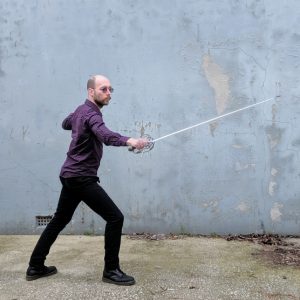 Winding up our set of interviews with Destreza instructors around Australia, we talked to Gindi Wauchope, who teaches at Preston, and Box Hill, in Melbourne (Australia). You will find him at The School of Historical Fencing, where he is the head instructor, having been there since he founded the school in 2015 (he started teaching in 2009).
Winding up our set of interviews with Destreza instructors around Australia, we talked to Gindi Wauchope, who teaches at Preston, and Box Hill, in Melbourne (Australia). You will find him at The School of Historical Fencing, where he is the head instructor, having been there since he founded the school in 2015 (he started teaching in 2009).
Gindi is a dedicated full time HEMA instructor and researcher. In his teaching practice he actively works to foster an inclusive and diverse teaching environment, helping everyone to grow towards meeting their HEMA goals. He ran what may have been the first young women’s (8-18yo) HEMA class in the world (to our knowledge and research attempts, at least!). He started with swords in the SCA as a child, which fostered important relationships, and lead to his lifelong practice of HEMA.
While largely retired from tournaments since becoming a parent, he will still be found at tournament events supporting people who train with him, some of whom have achieved considerable success on the Australian tournament circuit. He is currently working on a translation of Marozzo’s two handed sword material.
- What is your favourite Destreza action and why?
The movement of conclusion is my favourite Destreza action – it allows you to decisively win the fight without having to harm your opponent or needing to argue about points afterwards 😉
- When did you start HEMA and why?
I started HEMA as a teenager, regularly attending living history events with my family and needing something to do there. I was lucky that there were some very knowledgeable people available to me through the SCA. I still remember my first lesson in Destreza, it was at an SCA event where I asked Richard Cullinan to teach me some Spanish rapier and he obligingly taught me the Atajo. I think I would have been 16 or 17 at the time.
- What do you enjoy about teaching?
Teaching is the best way I can think of to refine one’s understanding of fencing and interpretation of a fencing system. If your students can pull off a correct technique under the pressure of competitive free play you know your interpretation of the technique is off to a good start. Successfully transmitting physical skills to another person is hugely satisfying. Even more satisfying when you accommodate the other person’s existing biases and understanding of fencing, and think of a demonstration or explanation that will make sense to them – that is when I feel like I am truly communicating with another person.
- Can you apply Destreza training in everyday life?
The principles of Destreza can be applied absolutely be applied in everyday life because the principles of Destreza are a true understanding geometry and physics which we are always subject to, especially if you fence every day 😉
- What else do you teach?
I also teach 15th, 16th and 17th C Italian fencing, in particular the chivalric combat system of Fiore dei Libri, the Dardi school of fencing from Bologna, and the rapier system common to Giganti, Capoferro, and Alfieri.
- How can you be contacted to organise lessons?
Get in touch for lessons via email to historicalfencingschool@gmail.com, on the school website: historicalfencing.com.au or via facebook https://www.facebook.com/historicalfencingschool/
Published 1st November 2019.
